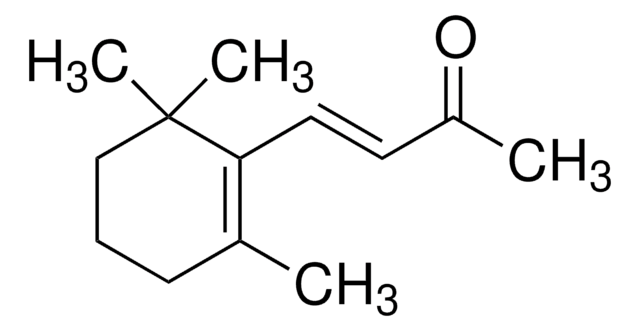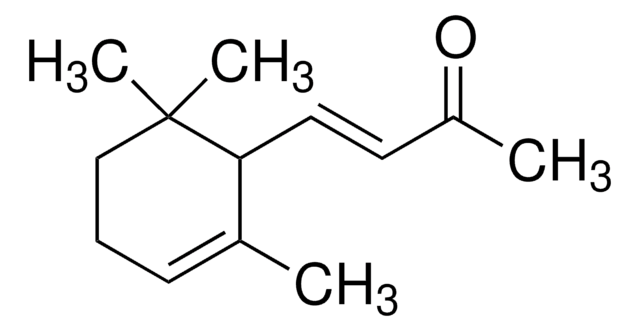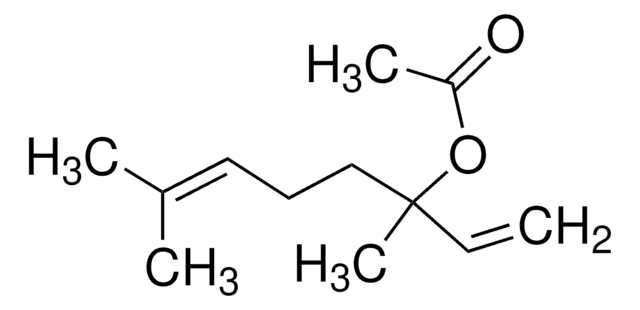W259500
β-Ionone
predominantly trans, ≥97%, FCC, FG
Synonym(s):
4-(2,6,6-Trimethyl-1-cyclohexenyl)-3-buten-2-one
About This Item
Fragrance grade
Kosher
Recommended Products
biological source
synthetic
Quality Level
grade
FG
Fragrance grade
Kosher
Agency
follows IFRA guidelines
reg. compliance
EU Regulation 1223/2009
EU Regulation 1334/2008 & 178/2002
FCC
FDA 21 CFR 117
FDA 21 CFR 172.515
Assay
≥97%
refractive index
n20/D 1.52 (lit.)
bp
126-128 °C/12 mmHg (lit.)
density
0.945 g/mL at 25 °C (lit.)
application(s)
flavors and fragrances
Documentation
see Safety & Documentation for available documents
food allergen
no known allergens
fragrance allergen
no known allergens
Organoleptic
berry; woody; floral; sweet
SMILES string
CC(=O)\C=C\C1=C(C)CCCC1(C)C
InChI
1S/C13H20O/c1-10-6-5-9-13(3,4)12(10)8-7-11(2)14/h7-8H,5-6,9H2,1-4H3/b8-7+
InChI key
PSQYTAPXSHCGMF-BQYQJAHWSA-N
Looking for similar products? Visit Product Comparison Guide
Related Categories
General description
Biochem/physiol Actions
Signal Word
Warning
Hazard Statements
Precautionary Statements
Hazard Classifications
Aquatic Chronic 2 - Skin Irrit. 2
Storage Class Code
10 - Combustible liquids
WGK
WGK 2
Personal Protective Equipment
Regulatory Listings
Regulatory Listings are mainly provided for chemical products. Only limited information can be provided here for non-chemical products. No entry means none of the components are listed. It is the user’s obligation to ensure the safe and legal use of the product.
FSL
Group 4: Flammable liquids
Type 3 petroleums
Hazardous rank III
Water insoluble liquid
JAN Code
W259500-VAR-K:
W259500-1KG:
W259500-20KG-K:
W259500-1KG-K:
W259500-10KG:
W259500-SAMPLE:
W259500-20KG:
W259500-SAMPLE-K:
W259500-BULK-K:
W259500-10KG-K:
Choose from one of the most recent versions:
Already Own This Product?
Find documentation for the products that you have recently purchased in the Document Library.
Customers Also Viewed
Global Trade Item Number
| SKU | GTIN |
|---|---|
| W259500-SAMPLE | |
| W259500-10KG | |
| W259500-10KG-K | 4061837515576 |
| W259500-1KG | |
| W259500-1KG-K | 4061837515583 |
| W259500-20KG | |
| W259500-20KG-K | 4061838191786 |
| W259500-SAMPLE-K | 4061837515590 |
Our team of scientists has experience in all areas of research including Life Science, Material Science, Chemical Synthesis, Chromatography, Analytical and many others.
Contact Technical Service












